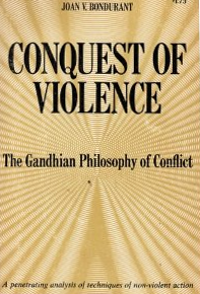
I recently read Joan V. Bondurant’s Conquest of Violence: The Gandhian Philosophy of Conflict.
Bondurant was working in military intelligence during World War Ⅱ and was assigned to India where she translated Japanese communications. While she was there she was exposed to Gandhi’s satyagraha techniques as they were being developed and put into use there, and she was impressed by what she saw and decided to give the subject some study. Her book was one of the first attempts to methodically describe the theory behind the use of satyagraha in political conflict.
(Bondurant seems to have had some instinctual appreciation of satyagraha ahead of time. Legend has it that when she went to learn Japanese in her eagerness to help the war effort, she was turned away — the class was for men only. So she sat outside the classroom door every day until they relented and let her in.)
Gandhi himself did not pause to try and rigorously delineate the contours of his theory. He explained himself briefly on many occasions, and you can piece together a picture of what he had in mind from various examples of these, but because he was developing his technique on-the-fly, experimenting and refining along the way, he sometimes contradicts himself, and the overall picture of what he developed can be a fuzzy one.
Bondurant’s is one attempt of many to try to make up for this lack of a formal understanding of satyagraha.
She starts by giving an introduction to what satyagraha is, how Gandhi developed it, and how he described it. She then tells how it played out in a variety of campaigns (including the Bardoli Satyagraha, of particular interest to people interested in mass tax resistance), and what generalizations we can draw from seeing how these campaigns played out.
Then she inquires into how much the success of satyagraha depended on the preexisting cultural context of Hinduism. (She suggests that while Gandhi was skilled at remixing the symbols and norms of Hinduism and of Indian culture to explain his technique, the technique itself is universal, and could just as easily be translated to another culture.)
Finally, she compares satyagraha, which is a theory of political action, to a variety of other, more static political theories — such as anarchism, Marxism, liberalism, autocratic idealism, and paleoconservatism. She finds that the means-are-the-ends philosophy of satyagraha give it an edge over other political philosophies that tend to be vague on the means to be used to bring about preferred ends or to resolve conflicts.
I found the book to be thought provoking in many parts, but also to be a little dry and sometimes wordy and vague.
Among the more interesting bits was the discussion of whether Gandhi could be considered an anarchist. Gandhi did not profess a particular political philosophy or theory of the state. Sometimes the things he said seemed to have no interpretation but an anarchist one; other times, he explicitly envisioned and promoted particular state-based action.
Bondurant suggests that part of the problem people have when trying to get a straight answer to this question is that they take for granted the traditional description of a state as an entity that claims a local monopoly on the legitimate use of violence. Just as Gandhi was innovating in developing nonviolent ways of projecting force or of resolving conflict, Bondurant thinks, he was also able to imagine a state-like institution that did not use or legitimize violence in its methods of projecting force or resolving conflict. So that when Gandhi spoke of ideal governments or states, he may not have been imagining anything that would necessarily make an anarchist upset.
